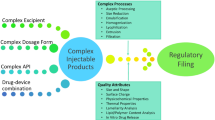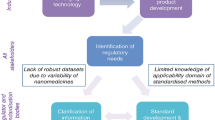Abstract
The aim of this critical review is to reach a global consensus regarding the introduction of follow-on versions of nonbiological complex drugs (NBCD). A nonbiological complex drug is a medicinal product, not being a biological medicine, where the active substance is not a homo-molecular structure, but consists of different (closely related and often nanoparticulate) structures that cannot be isolated and fully quantitated, characterized and/or described by state of the art physicochemical analytical means and where the clinical meaning of the differences is not known. The composition, quality and in vivo performance of NBCD are highly dependent on manufacturing processes of both the active ingredient as well as in most cases the formulation. The challenges posed by the development of follow-on versions of NBCD are illustrated in this paper by discussing the ‘families’ of liposomes, iron–carbohydrate (‘iron–sugar’) drugs and glatiramoids. It is proposed that the same principles for the marketing authorization of copies of NBCD as for biosimilars be used: the need for animal and/or clinical data and the need to show similarity in quality, safety and efficacy. The regulatory approach of NBCD will have to take into consideration the specific characteristics of the drugs, their formulation and manufacturing process and the resulting critical attributes to achieve their desired quality, safety and efficacy. As with the biosimilars, for the NBCD product, family-specific methods should be evaluated and applied where scientifically proven, including sophisticated quality methods, pharmacodynamic markers and animal models. Concerning substitution and interchangeability of NBCD, it is also advisable to take biosimilars as an example, i.e. (1) substitution without the involvement of a healthcare professional should be discouraged to ensure traceability of the treatment of individual patients, (2) keep an individual patient on a specific treatment if the patient is doing well and only switch if unavoidable and (3) monitor the safety and efficacy of the new product if switching occurs.



Similar content being viewed by others
REFERENCES
Crommelin DJA., de Vlieger JSB, Weinstein V, Mühlebach S, Shah VP, Schellekens H. Different pharmaceutical products need similar terminology. 2013. doi:10.1208/s12248-013-9532-0.
Schellekens H, Klinger E, Mühlebach S, Brin JF, Storm G, Crommelin DJA. The therapeutic equivalence of complex drugs. Regul Toxicol Pharmacol. 2011;59:176–83.
Holloway C, Mueller-Berghaus J, Lima BS, Lee SL, Wyatt JS, Nicholas JM, et al. Scientific considerations for complex drugs in light of established and emerging regulatory guidance. Ann N Y Acad Sci. 2012;1276:26–36. doi:10.1111/j.1749-6632.2012.06811.
Chang HI, Yeh MK. Clinical development of liposome-based drugs: formulation, characterization, and therapeutic efficacy. Int J Nanomed. 2012;7:49–60.
Mamidi RNVS, Weng S, Stellar S, Wang C, Yu N, Huang T, et al. Pharmacokinetics, efficacy and toxicity of different pegylated liposomal doxorubicin formulations in preclinical models: is a conventional bioequivalence approach sufficient to ensure therapeutic equivalence of pegylated liposomal doxorubicin products? Cancer Chemother Pharmacol. 2010;66:1173–84.
Barenholz Y. Doxil®—the first FDA-approved nano-drug: lessons learned. J Control Release. 2012;160:117–34.
FDA. Draft guidance on doxorubicin hydrochloride, February 2010, http://www.fda.gov/downloads/Drugs/…/Guidances/UCM199635.pdf. Accessed 3 Dec 2012.
EMA Committee for Medicinal Products for Human Use CHMP. Draft reflection paper on the data requirements for intravenous liposomal products developed with reference to an innovator liposomal product, 2011. http://www.ema.europa.eu/docs/en_GB/document_library/Scientific_guideline/2011/07/WC500109479.pdf. Accessed 3 Dec 2012.
Ehmann F, Saka-Kato K, Duncan R, Hernan Perez de la Ossa D, Pita R, Vidal J-M, et al. Next generation nanomedicines and nanosimilars: EU regulators’ initiatives relating to the development and evaluation of nanomedicines. Nanomedicine. 2013;8:849–56.
Borchard G, Flühmann B, Mühlebach S. Nanoparticle iron medicinal products—requirements for approval of intended copies of non-biological complex drugs (NBCD) and the importance of clinical comparative studies. Reg Tox Pharm. 2012;64:324–8.
FDA. Therapeutic equivalence of generic iron complex products (solicitation for a study on Na ferric gluconate; Nulecit (follow-on upon 505j approval) vs Ferrlecit (originator). https://www.fbo.gov/index?s=opportunity&mode=form&id=592788989854da145c8e7b6d103c898d&tab=core&tabmode=list&. Accessed 30 June 2013.
Martin-Malo A, Merino A, Carracedo J, Alvarez-Lara MA, Ojeda R, Soriano S, et al. Effects of intravenous iron on mononuclear cells during haemodialysis session. Nephrol Dial Transplant. 2012;27:2465–71.
Lee ES, Park BR, Kim JS, Lee JJ, Lee IS. Comparison of adverse event profile of intravenous iron sucrose and iron sucrose similar in postpartum and gynecologic operative patients. Curr Med Res Opin. 2013;29:141–7.
Rottembourg J, Kadri A, Leonard E, et al. Do two intravenous iron sucrose preparations have the same efficacy? Nephrol Dial Transplant. 2011;26:3262–7.
Stein J, Chow AK. Clinical case reports raise doubts about the therapeutic equivalence of an iron sucrose similar preparation compared with iron sucrose originator. Curr Med Res Opin. 2012;28:241–3.
Ghoti H, Rachmilewitz E, Simon-Lopez R, et al. Evidence for tissue iron overload in long-term hemodialysis patients and the impact of withdrawing parenteral iron. Eur J Hematol. 2012;89:87–93.
Toblli JE, Cao G, Oliveri L, Angerosa M. Comparison of oxidative stress and inflammation induced by different intravenous iron sucrose preparation in a rat model. Inflamm Allergy Drug Targets. 2012;11:66–78.
EMA Committee for Medicinal Products for Human Use (CHMP). Reflection paper on non-clinical studies for generic nanoparticle iron medicinal product applications 17 March 2011, EMA/CHMP/SWP/100094/2011. http://www.ema.europa.eu/docs/en_GB/document_library/Scientific_guideline/2011/04/WC500105048.pdf. Accessed 3 Dec 2012.
FDA. Draft guidance on iron sucrose bioequivalence 2012 (March). http://www.fda.gov/downloads/Drugs/GuidanceComplianceRegulatoryInformation/Guidances/UCM297630.pdf Accessed 3 Dec 2012.
Varkony H, Weinstein V, Klinger E, Sterling J, Cooperman H, Komlosh T, et al. The glatiramoid class of immunomodulator drugs. Expert Opin Pharmacother. 2009;10(4).
Citizen Petition submitted by Teva to the FDA, June 4, 2012 http://www.regulations.gov/contentStreamer?objectId=0900006481031791&disposition=attachment&contentType=pdf. Accessed 3 Dec 2012.
Nicholas JM. Complex drugs and biologics: scientific and regulatory challenges for follow-on products. Drug Inf J. 2012;46(197).
Bakshi S, Chalifa-Caspi V, Plaschkes I, Perevozkin I, Gurevich M, Schwartz R. Gene expression analysis reveals functional pathways of glatiramer acetate activation. Expert Opin Ther Targets. 2013;17(4):351–62.
European Medicines Agency. Guideline on similar biological medicinal products. London, UK, 30 October 2005. www.emea.europa.eu/docs/en_GB/document_library/Scientific_guideline/2009/09/WC500003517.pdf. Accessed 3 Dec 2012.
CDER. Guidance for industry: scientific considerations for demonstrating biosimilarity to a reference product. US Food and Drug Administration: 9 February 2012. www.fda.gov/downloads/Drugs/GuidanceComplianceRegulatoryInformation/Guidances/UCM291128.pdf. Accessed 3 Dec 2012.
ACKNOWLEDGMENTS
This paper was written within the framework of the Non Biological Complex Drugs Working Group, hosted at TI Pharma (the Dutch Top Institute Pharma). The NBCD Working Group is currently supported by Vifor Pharma International Inc., Teva Pharmaceutical Industries Ltd. and Sanofi-Aventis Groupe. The authors acknowledge the valuable input of the participants during the discussions at the AAPS, FIP, DIA, EUFEPS and other conferences.
Author information
Authors and Affiliations
Corresponding author
Rights and permissions
About this article
Cite this article
Schellekens, H., Stegemann, S., Weinstein, V. et al. How to Regulate Nonbiological Complex Drugs (NBCD) and Their Follow-on Versions: Points to Consider. AAPS J 16, 15–21 (2014). https://doi.org/10.1208/s12248-013-9533-z
Received:
Accepted:
Published:
Issue Date:
DOI: https://doi.org/10.1208/s12248-013-9533-z




